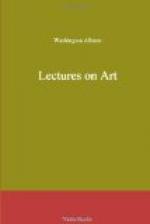Admitting this personal modification, we may then safely repeat our position,—that to hate Good or to love Evil, solely for their own sakes, is only possible with the irredeemably wicked, in other words, with devils.
We now proceed to the latter clause of our general proposition. And here it may be asked, on what ground we assume one intuitive universal Principle as the true source of all those emotions which have just been discussed. To this we reply, On the ground of their common agreement. As we shall here use the words effect and emotion as convertible terms, we wish it to be understood, that, when we apply the epithet common or same to effect, we do so only in relation to kind, and for the sake of brevity, instead of saying the same class of effects; implying also in the word kind the existence of many degrees, but no other difference. For instance, if a beautiful flower and a noble act shall be found to excite a kindred emotion, however slight from the one or deep from the other, they come in effect under the same category. And this we are forced to admit, however heterogeneous, since a common ground is necessarily predicated of a common result. How else, for instance, can we account for a scene in nature, a bird, an animal, a human form, affecting us each in a similar way? There is certainly no similitude in the objects that compose a landscape, and the form of an animal and man; they have no resemblance either in shape, or texture, or color, in roughness, smoothness, or any other known quality; while their several effects are so near akin, that we do not stop to measure even the wide degrees by which they are marked, but class them in a breath by some common term. It is very plain that this singular property of assimilating to one what is so widely unlike cannot proceed from any similar conformation, or quality, or attribute of mere being, that is, of any thing essential to distinctive existence. There must needs, then, be some common ground for their common effect. For if they agree not in themselves one with the other, it follows of necessity that the ground of their agreement must be in relation to something within our own minds, since only there is this common effect known as a fact.




